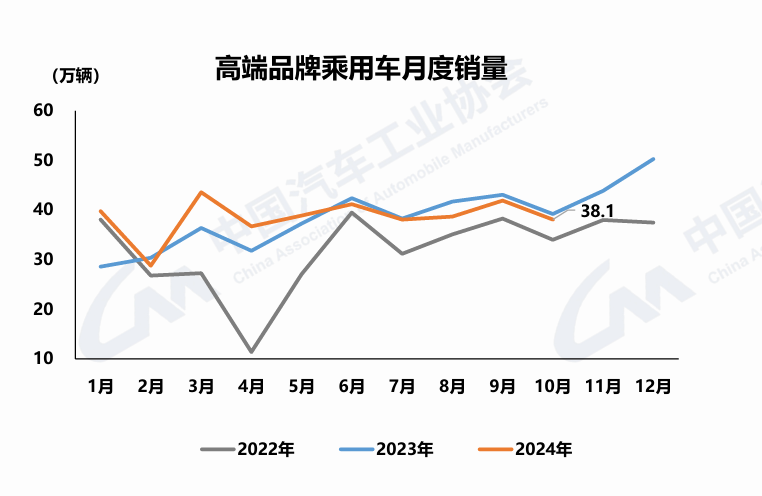The rise of new energy vehicles in the Chinese market is one of the main drivers driving the industry's revenue growth. A series of policies introduced by the government, such as purchase tax reduction, license concessions and charging infrastructure construction, have greatly promoted the popularization of new energy vehicles. In 2023, the production and sales of new energy vehicles will both increase by more than 50% year-on-year. Although the growth rate of traditional fuel vehicles has slowed down due to environmental protection policies and increased market saturation, it still shows strong growth momentum in some segments, such as luxury cars and SUVs. The relevance and driving force of the automotive industry are also increasing, involving parts supply, logistics and transportation, sales and service and other links. With the development of the automotive industry, related upstream and downstream enterprises have also grown simultaneously.
According to the China Association of Automobile Manufacturers, the proportion of Chinese brand passenger car sales has further increased. In October 2024, the sales volume of Chinese brand passenger cars was 1.931 million units, an increase of 30% year-on-year, and the sales share was 70.1%, an increase of 0.4 percentage points from the same period last year. The cumulative sales from January to October were 17.835 million units, a year-on-year increase of 3.2%. The cumulative retail sales of the new energy passenger vehicle market have reached 8.416 million units, a year-on-year increase of 41%. Annual sales of new energy passenger vehicles are expected to reach 12 million units. In January ~ October 2024, the cumulative retail sales of new energy passenger vehicles in China will be 8.327 million units, a year-on-year increase of 39.8%.

Figure:Monthly sales of high-end brand passenger cars (Source: China Association of Automobile Manufacturers)
In addition, the report of the China Association of Automobile Manufacturers also pointed out that from January to October, the sales of traditional fuel passenger vehicles in all levels decreased to varying degrees. At present, sales are still mainly concentrated in the A-class, with cumulative sales of 6.68 million units, a year-on-year decrease of 14.5%. From January to October, the sales of new energy passenger vehicles in all levels showed varying degrees of growth, among which the D-class increased the most, and the current sales were mainly concentrated in the A-class and B-class, with cumulative sales of 2.86 million and 3.14 million respectively, an increase of 3.9% and 77.2% year-on-year respectively.

Figure: Sales volume and growth rate of conventional fuel passenger vehicles by class
According to a report by the China Association of Automobile Manufacturers, the mainstream price range of new energy passenger vehicles is higher than that of traditional fuel passenger vehicles. From January to October, among the traditional fuel passenger vehicles, the sales volume in the price range of 8-100,000, 15-200,000 and 40-500,000 yuan showed positive year-on-year growth, and the sales volume in other price ranges showed negative growth. At present, sales are still mainly concentrated in the price range of 10-150,000 units, with cumulative sales of 4.045 million units, a year-on-year decrease of 14.6%. From January to October, among the new energy passenger vehicles, except for the sales in the price range of 400,000-500,000 yuan decreased year-on-year, the sales volume in other price ranges showed positive growth, of which the price range of more than 500,000 yuan increased the most. At present, sales are still mainly concentrated in the price range of 15-200,000 units, with cumulative sales of 2.587 million units, a year-on-year increase of 16.4%.

Figure: Sales volume and growth rate of new energy passenger vehicles by price range
In terms of domestic sales, the domestic sales of new energy vehicles accounted for more than 50% for three consecutive months. In October, NEV production and sales totaled 1.463 million units and 1.43 million units, up 48% and 49.6% y/y, respectively, and new NEV sales accounted for 46.8% of total new vehicle sales. According to the report of the China Association of Automobile Manufacturers, from January to October, the total sales volume of the top 10 enterprise groups in new energy vehicle sales was 8.348 million units, a year-on-year increase of 33.8%, accounting for 85.6% of the total sales of new energy vehicles, 0.1 percentage points lower than the same period last year.

Figure: The total sales volume of the top 10 new energy vehicle sales companies increased rapidly year-on-year
Vehicle exports in October totaled 542,000 units, reflecting a 0.5% m/m increase and an 11.1% y/y increase. Passenger car exports totaled 465,000 units, reflecting a 1.8% m/m increase and a 10.7% y/y increase. Commercial vehicle exports totaled 76,000 units, reflecting a 6.6% m/m decrease and a 13.6% y/y increase. Vehicle exports from January to October totaled 4.855 million units, reflecting a 23.8% y/y increase. Passenger car exports totaled 4.1 million units, reflecting a 24% y/y increase. Commercial vehicle exports totaled 755,000 units, reflecting a 22.5% y/y increase. Both traditional fuel vehicles and new energy vehicles increased year-on-year. From January to October, the export of pure electric vehicles was 836,000 units, a year-on-year increase of 2 times.

Figure: Total exports and growth rate of plug-in hybrid vehicles
According to data from the General Administration of Customs compiled by the China Association of Automobile Manufacturers, vehicle exports in September totaled 609,000 units, reflecting a 0.3% m/m decrease and a 22.7% y/y increase. NEV exports totaled 183,000 units, reflecting a 5.5% m/m increase and a 7.2% y/y increase.
Vehicle exports from January to September totaled 4.7 million units, reflecting a 26.6% y/y increase. Exports of new energy vehicles totaled 1.522 million units, reflecting a 22.2% y/y increase. Russia, Mexico, and the United Arab Emirates are among the top three in terms of vehicle exports. The top three markets for NEV exports are Belgium, Brazil and the United Kingdom.
Related:






